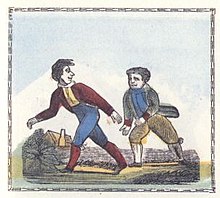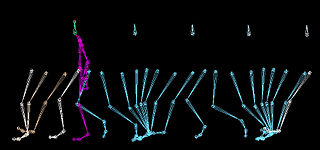
Walking is one of the main gaits of terrestrial locomotion among legged animals. Walking is typically slower than running and other gaits. Walking is defined by an "inverted pendulum" gait in which the body vaults over the stiff limb or limbs with each step. This applies regardless of the usable number of limbs—even arthropods, with six, eight, or more limbs, walk. In humans, walking has health benefits including improved mental health and reduced risk of cardiovascular disease and death.

Athletics is a group of sporting events that involves competitive running, jumping, throwing, and walking. The most common types of athletics competitions are track and field, road running, cross-country running, and racewalking.

Long-distance running, or endurance running, is a form of continuous running over distances of at least 3 km (1.9 mi). Physiologically, it is largely aerobic in nature and requires stamina as well as mental strength.

A pedestrian is a person traveling on foot, whether walking or running. In modern times, the term usually refers to someone walking on a road or pavement, but this was not the case historically.

An ultramarathon, also called ultra distance or ultra running, is a footrace longer than the traditional marathon length of 42.195 kilometres. Various distances, surfaces, and formats are raced competitively, from the shortest common ultramarathon of 31 miles (50 km) and up to 3100 miles. World Championships are held by the International Association of Ultrarunners (IAU) for 50 km, 100 km, 24 hours, and ultra trail running. The Global Organization of Multi-Day Ultramarathoners (GOMU) holds World Championships for 48 hours and 6 days. World Records are ratified and recognized by World Athletics, the IAU, and by GOMU.

Race walking, or racewalking, is a long-distance discipline within the sport of athletics. Although a foot race, it is different from running in that one foot must appear to be in contact with the ground at all times. Race judges carefully assess that this is maintained throughout the race. Typically held on either roads or running tracks, common distances range from 3,000 metres (1.9 mi) up to 100 kilometres (62.1 mi).

Robert Barclay Allardice of Ury, generally known as Captain Barclay, was a notable Scottish walker of the early 19th century, known as the celebrated pedestrian. His most famous feat was walking 1000 miles in 1000 hours for 1000 guineas in 1809. He is considered the father of the 19th-century sport of pedestrianism, a precursor to racewalking.
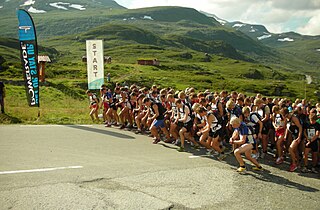
Fell running, also sometimes known as hill running, is the sport of running and racing, off-road, over upland country where the gradient climbed is a significant component of the difficulty. The name arises from the origins of the English sport on the fells of northern Britain, especially those in the Lake District. It has elements of trail running, cross country and mountain running, but is also distinct from those disciplines.
Multiday races are ultramarathon running events which are typically either segmented into daily events of a specified distance or time, or staged so that runners can run as far as they want, at their own discretion, over a set course or over a set number of days. Multiday races can range from continuous 48-hour track events to staged transcontinental treks.

Edward Payson Weston was a pedestrian, who was largely responsible for the rise in popularity of the sport in the 1860s and 1870s.
The 6-Day Race became a standard footrace distance in the 1870s and was a popular form of entertainment with up to 70,000 paying visitors during such a Pedestrians event. However the widespread use of the bicycle from 1890 caused it to be replaced as spectator sport by cycle races of the same duration. It was in two forms: strict "heel-and-toe" racewalking, or "go-as-you-please" combination of walking, jogging, running.
The Brotherhood of Centurions is a club for which racewalkers are eligible who have completed a distance of 100 international miles (160.9 km) in Britain within 24 hours. Its name derives from a popular title from those competitors achieving the feat in the 19th century British long-distance walking sport, called Pedestrianism.

Len Hurst was renowned as a British long-distance athlete, both running and pedestrianism, although he started life as a brick-maker, and spent his last 29 years as a pub landlord.
The following outline is provided as an overview of and topical guide to running:
Athletics has a long history in Wales, with many events recognised today codified during the Victorian period. The first amateur athletic clubs in Wales were formed in the 1870s, while the first championships began in the early 20th century. Wales began competing as a country in international athletic events in the 1920s and has since produced a notable number of world class sportspeople including many medal winning Commonwealth, World, Olympic, Paralympic and European champions. Wales competes in the Commonwealth Games under its own flag but at the Olympic Games, Welsh athletes compete alongside those of Scotland, England and Northern Ireland as part of a Great Britain team.
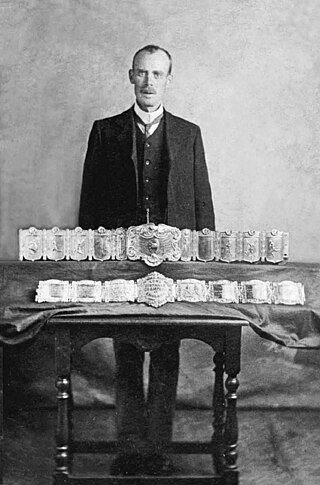
George Littlewood (1859–1912) was a professional pedestrian known as the Sheffield Flyer who still holds the 6-day world record for walking. This was achieved in Sheffield, England, between 6 and 11 March 1882, on a 13-lap to the mile track, 531 miles.
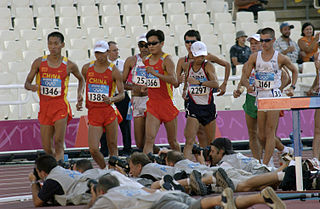
Race walking events at the Summer Olympics have been contested over a variety of distances at the multi-sport event. There were three race walking events in the 2020 Summer Olympics: a men's and a women's 20 kilometres walk, and a men's 50 kilometres walk. The races were held in a final-only format.

Charles Rowell (1852–1909) was an English athlete: a famous runner and celebrated exponent of the sport of pedestrianism race-walking.

Emma Sharp (1832–1920) was an athlete famous for her feat of pedestrianism completing a 1000-mile walk in 1000 hours, the event first completed by Robert Barclay Allardice in 1809. She is thought to be the first woman to complete the challenge, which lasted from 17 September to 29 October 1864. This 'arduous task' was reported in the newspapers of the day, in which she was described as having a medium build but an active frame, dressed in male clothing with the exception of her straw hat which was adorned with 'feminine ornaments'.
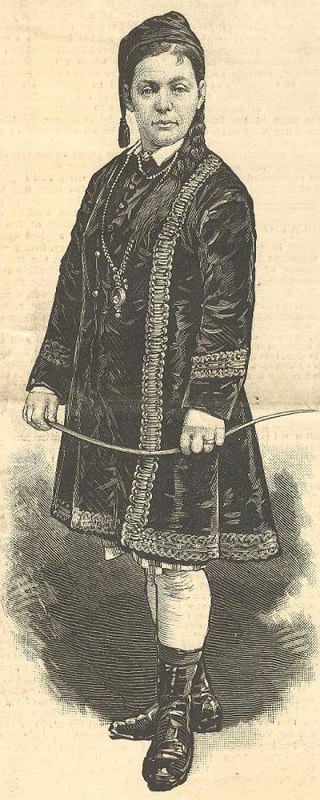
Ada Anderson, née Nymand was a British athlete famous for her feats of pedestrianism in the latter half of the 19th century. She set various records for distance covered in a given time period, becoming known as ‘Champion Lady Walker of the World’. After becoming the dominant pedestrian in the United Kingdom, she participated in similar events in the United States to great acclaim.
